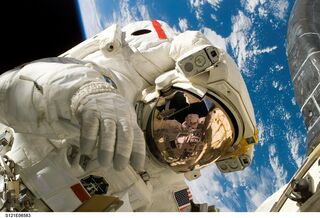New Evidence That Spaceflight Changes Astronaut Brains
The good news: It has nothing to do with neurodegeneration.
by Samantha Jones, Ph.D.People have been interested in the short- and long-term effects of space travel since astronauts first left Earth’s atmosphere for an environment of spectacular views, increased radiation, social isolation, and microgravity.
Humans are surprisingly adaptable—we’re able to adjust to a variety of physical environments, including the inside of a spacecraft that's floating in space. But what are the neurological consequences of that adjustment?

Previous work has been done to understand functional brain changes after long-duration spaceflight—last year I wrote about one of them—and has indicated sensorimotor changes as well as structure and volume changes in grey matter (GM), white matter (WM), and cerebrospinal fluid (CSF). WM and GM are essential for different regions of your brain to communicate, allowing for normal movement and cognition, and CSF protects your brain while providing nourishment and removing waste.
Unfortunately, these studies could only tell us about larger-scale brain changes, as opposed to smaller changes in tissue structure, and whether or not those changes were linked to neurodegeneration (brain tissue loss) remained unclear.
In a study published in Science Advances earlier this month, researchers analyzed brain diffusion magnetic resonance imaging (dMRI, a technique that tells you about a structure by measuring the diffusion of water molecules throughout it) data from 11 Russian male cosmonauts who went to space for a long-duration mission. The researchers used a technique called multi-tissue spherical deconvolution, which allowed them to detect both macroscopic and microscopic brain changes. They analyzed these cosmonauts' GM, WM, and CSF from dMRI data acquired preflight, nine days postflight, and seven months postflight.
Seven months after the space mission, most early postflight changes had returned to preflight levels, but researchers still found increased WM in the cerebellums of the cosmonauts, indicating sensorimotor neuroplasticity—the formation of new neural connections that affect how we sense and respond to our environment. They saw something similar in GM tissue in the basal ganglia, a structure at the base of our brains that’s important for coordination.
There was no evidence of neurodegeneration in any of their findings.

Although this study was a big step in the right direction, it was still limited. Eleven subjects is a larger sample group than most past studies, but it’s still small. And, although findings were consistent across cosmonauts, there was a mix of first-time and experienced flyers, which could affect baseline, preflight brain comparisons.
As technologies progress and the number of people traveling to space increases, soon we’ll hopefully learn even more about travel (and how our bodies handle it) beyond our Pale Blue Dot.